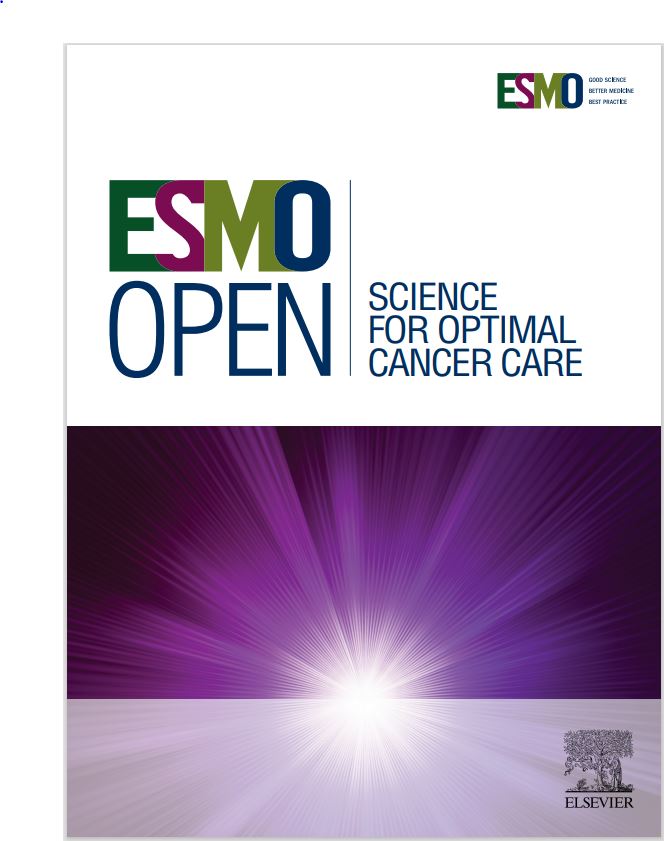随机UNIRAD试验中依维莫司辅助治疗根据内分泌治疗骨干的不同获益
IF 7.1
2区 医学
Q1 ONCOLOGY
引用次数: 0
摘要
背景对高危早期管腔型乳腺癌患者在内分泌治疗的基础上加用2年依维莫司进行评估的随机双盲UNIRAD试验未能显示出治疗效果。我们以 1 : 1 的比例随机分配了 1278 名患者,让他们接受为期 2 年的安慰剂或依维莫司治疗,并在开始内分泌治疗后最多持续 4 年。随机分配按照内分泌治疗药物、之前的辅助治疗与新辅助治疗、孕酮受体表达和淋巴结受累情况进行了分层。按每个分层因素进行的亚组分析都是预先指定的。根据绝经状态和年龄进行了事后分析。结果我们观察到他莫昔芬治疗患者的预后特征呈有限的有利趋势,雌激素受体阳性/孕激素受体阳性肿瘤的发生率更高(88.5%对84.1%,P = 0.026),pN2阳性的发生率更低(39.8%对46.0%,P = 0.032)。在绝经前妇女中,我们观察到依维莫司在数量上的益处:安慰剂组的 3 年无病生存率为 86%,依维莫司组为 90%(危险比为 0.76,95% 置信区间为 0.43-1.34)。在接受他莫昔芬治疗的绝经前患者(n = 153;12.3%)中,我们观察到依维莫司的优势趋势更强,安慰剂组的 3 年无病生存率为 84%,依维莫司组为 91%(危险比为 0.54,95% 置信区间为 0.28-1.02)。他莫昔芬组早期停用依维莫司或安慰剂的比例低于芳香化酶抑制剂组:结论本研究通过事后分析,对高危、ER阳性、人类表皮生长因子受体2型阴性早期乳腺癌患者绝经状态、他莫昔芬和依维莫司之间的相互作用提出了假设。这些研究表明,对于绝经前的高危患者来说,单独使用他莫昔芬是一种效果不佳的内分泌治疗方法。本文章由计算机程序翻译,如有差异,请以英文原文为准。

Differential benefit of adjuvant everolimus according to endocrine therapy backbone in the randomized UNIRAD trial
Background
The randomized, double-blind UNIRAD trial evaluating the addition of 2 years of everolimus to endocrine therapy in patients with high-risk, early luminal breast cancer failed to demonstrate a benefit. We report the subgroup analyses.
Patients and methods
We randomly assigned 1278 patients in a 1 : 1 ratio to receive 2 years of placebo or everolimus, added to endocrine therapy for up to 4 years after initiation. Randomization was stratified by endocrine therapy agent, prior adjuvant versus neoadjuvant therapy, progesterone receptor expression, and lymph node involvement. Subgroup analyses by each stratification factor were pre-specified. Post hoc analyses were carried out according to menopausal status and age. Treatment adherence was also analyzed.
Results
We observed a limited trend toward more favorable prognostic features in tamoxifen-treated patients, with more frequent estrogen receptor-positive/progesterone receptor-positive tumors (88.5% versus 84.1%, P = 0.026) and less frequent pN2-positive status (39.8% versus 46.0%, P = 0.032). In premenopausal women, we observed a numerical benefit of everolimus: 3-year disease-free survival was 86% in the placebo group and 90% in the everolimus group (hazard ratio 0.76, 95% confidence interval 0.43-1.34). In premenopausal patients treated with tamoxifen (n = 153; 12.3%), we observed an even stronger trend in favor of everolimus as 3-year DFS was 84% in the placebo group and 91% in the everolimus group (hazard ratio 0.54, 95% confidence interval 0.28-1.02). Early discontinuation of either everolimus or placebo was less frequent in the tamoxifen group than in the aromatase inhibitor group: 48.0% versus 56.9% (P = 0.028).
Conclusions
The present post hoc analyses generate hypotheses regarding the interaction between menopausal status, tamoxifen, and everolimus in patients with high-risk, ER-positive, human epidermal growth factor receptor type 2-negative early breast cancer. They suggest that tamoxifen alone is an underpowered endocrine treatment in high-risk premenopausal patients.
求助全文
通过发布文献求助,成功后即可免费获取论文全文。
去求助
来源期刊

ESMO Open
Medicine-Oncology
CiteScore
11.70
自引率
2.70%
发文量
255
审稿时长
10 weeks
期刊介绍:
ESMO Open is the online-only, open access journal of the European Society for Medical Oncology (ESMO). It is a peer-reviewed publication dedicated to sharing high-quality medical research and educational materials from various fields of oncology. The journal specifically focuses on showcasing innovative clinical and translational cancer research.
ESMO Open aims to publish a wide range of research articles covering all aspects of oncology, including experimental studies, translational research, diagnostic advancements, and therapeutic approaches. The content of the journal includes original research articles, insightful reviews, thought-provoking editorials, and correspondence. Moreover, the journal warmly welcomes the submission of phase I trials and meta-analyses. It also showcases reviews from significant ESMO conferences and meetings, as well as publishes important position statements on behalf of ESMO.
Overall, ESMO Open offers a platform for scientists, clinicians, and researchers in the field of oncology to share their valuable insights and contribute to advancing the understanding and treatment of cancer. The journal serves as a source of up-to-date information and fosters collaboration within the oncology community.
 求助内容:
求助内容: 应助结果提醒方式:
应助结果提醒方式:


